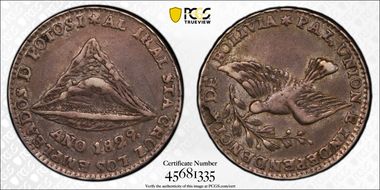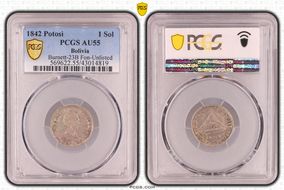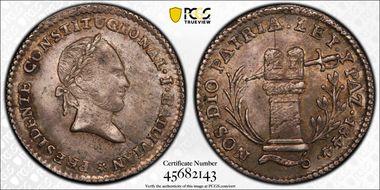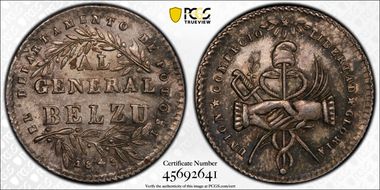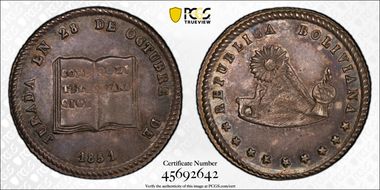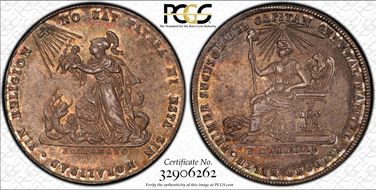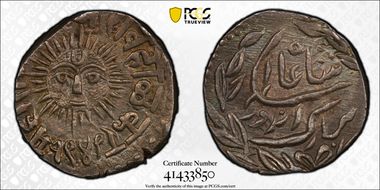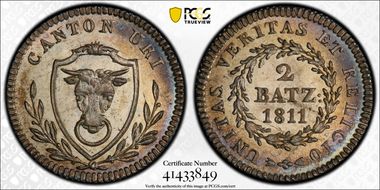ajc_coins 的钱币相册
A pleasing example with some high point wear and original toning. Although it's listed as a 1 Sol by Burnett and Fonrobert, it is smaller and is very likely a ⅛ Peso. Struck during the rule of José María de Achá, the 14th President of Bolivia (1861-4). José María Linares, the first civilian president of Bolivia, was initially an honest and popular ruler. However, his reforms resulted in many threats to his rule, and he declared himself Dictator for Life in 1858. His Minister of War, José María de Achá, staged a coup d'état against him. Achá would soon face similar turmoil and rebellion, and was overthrown in 1864. Although Bolivian proclamation coins are not listed in standard catalogs as coins, there is a significant amount of evidence that they were coins and used as such in commerce. A comprehensive argument was made by Paul J. Bosco in 1980, with others adding important evidence. An important contributor was Dr. Richard Doty, who demonstrated that the metrology of the proclamations is exactly the same as contemporary denominations. Some major points include that: -Between 1830 and 1852 there were no silver minors minted, but a large quantity of proclamation coins were. -Sizes correspond to exact denominations. Dies, edges, and sizes are the same as for regular coins. -Designs were not shared for gold and silver pieces as they would be for medals. -They were recorded in Argentinian conversion tables used in the 19th century. -Contemporary documents refer to them as coins -Pieces are usually found worn and often holed, suggesting their use in commerce. -1400 pieces were found in a Cochabamba bank's vault -Many were struck over previous coinage from the realm. Despite this, they are still not included in the Standard Catalogue of World Coins, and are instead officially termed as “monetary medals”.
Plate coin for the HMZ Catalog. 2.74 g. D.T. 76. HMZ 2-993a. Prachtvolle Erhaltung. FDC / Cabinet piece. Brilliant uncirculated. Kleiner Schrötlingsfehler / Minor flan flaw. Uri didn't mint many of its own coins during the joint minting period with Schwyz and Nidwalden. The majority of their own issues were produced in the first half of the 17th century, and they issued just four coins in the 18th century (four years of the same ducat). The four coins that were in the 1811 series were the first they'd made in 75 years, and the last that they would ever mint.
Artex restruck 2,000 each of the 1947, 1948, and 1950 versions on “citrom” planchets without rosettes. The resulting coins have a color more yellow than the original alubronze. Historical Background: Hungary signed the Tripartite Act in 1940, joining the Axis powers. They would later begin peace negotiations with the allies in 1943, but due to suspicions from Berlin they were occupied by Germany in 1944. Hungary was a major participant in the Holocaust. During the war, the Arrow Cross Party and Hungarian Police deported nearly 440,000 Jews, with the majority sent to Auschwitz. Post-war in 1946, Hungary would have the worst monthly inflation rate ever: 41.9 quadrillion percent, with prices doubling every 15.3 hours. For comparison, the highest monthly inflation rate in Zimbabwe was 79.6 billion percent. Hungary’s currency would soon be redenominated at a rate of 4x10^29 Pengo to 1 Forint, and new coinage was issued in the same year. 1 Filler = 1/100 of a Forint.
SASANIAN KINGS. Ardashir I, 223/4-240. Hemidrachm (Silver, 19 mm, 2.00 g, 3 h), Mint B (Hamadan). MZDYSN BGY 'RTHŠTR MRKAN MRKA 'YR'N MNW CTRY MN YZD'N ('Worshipper of Lord Mazda, 'God' Ardashir, King of Kings of Iran who has lineage from the Gods' in Pahlawi) Draped bust of Ardashir I to right, wearing diadem and close-fitting headdress with korymbos and no earflaps. Rev. NWRA ZY 'RTHŠTR ('Fire of Ardashir' in Pahlawi) Fire altar with diadems. SNS I, pl. 15, 215. Beautifully toned. Very fine. From the collection of Augustin de Loye (1816-1898), curator of the Calvet library and Museum in Avignon.




















